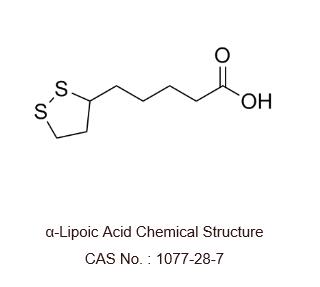
| Description | α-Lipoic Acid is an antioxidant, which is an essential cofactor of mitochondrial enzyme complexes. α-Lipoic Acid inhibits NF-κB-dependent HIV-1 LTR activation. | ||||||||||||||||
| IC50 & Target | NF-κB[1] HIV[1] Mitochondrial[2] |
||||||||||||||||
| In Vitro | The long terminal repeat (LTR) of HIV-1 is the target of cellular transcription factors such as NF-κB, and serves as the promoter-enhancer for the viral genome when integrated in host DNA[1]. α-Lipoic Acid (Alpha-Lipoic acid, ALA), a naturally occurring dithiol compound, plays an essential role in mitochondrial bioenergetics. α-Lipoic Acid reduces lipid accumulation in the liver by regulating the transcriptional factors SREBP-1, FoxO1, and Nrf2, and their downstream lipogenic targets via the activation of the SIRT1/LKB1/AMPK pathway. Treatment of cells with α-Lipoic Acid (250, 500 and 1000 μM) significantly increases the NAD+/NADH ratio in HepG2 cells (P<0.05 or P<0.01). Treatment with α-Lipoic Acid (50, 125, 250 and 500 μM) increases SIRT1 activity in HepG2 cells. α-Lipoic Acid (50, 125, 250, 500 and 1000 μM) increases phosphorylation of AMPK and acetyl-CoA carboxylase (ACC) in HepG2 cells in a dose-dependent fashion[1]. | ||||||||||||||||
| In Vivo | C57BL/6J mice, divided into four groups, are fed an high-fat diet (HFD) for 24 weeks to induce nonalcoholic fatty liver disease (NAFLD) followed by daily administration of α-Lipoic Acid. Then, the effects of α-Lipoic Acid on hepatic lipid accumulation in long-term HFD-fed mice are assessed. Administration of α-Lipoic Acid (100 mg/kg or 200 mg/kg) markedly reduces visceral fat mass in mice. In addition, α-Lipoic Acid (100 mg/kg or 200 mg/kg) treatment inhibits the appetite and causes a dramatic weight loss (all P<0.05)[1]. | ||||||||||||||||
| Preparing Stock Solutions |
Please refer to the solubility information to select the appropriate solvent. |
||||||||||||||||
| Cell Assay [1] |
The human hepatocellular carcinoma (HepG2) cell line is cultured in Dulbecco’s modified Eagle’s medium containing 10% fetal bovine serum at 37°C and 5% CO2. HepG2 cells are treated with AMPK inhibitor (CC, 20 μM, 0.5 h), SIRT1 inhibitor (NA, 10 mM, 12 or 24 h), and AMPK activator (AICAR, 2 mM, 1 h), Palmitate (PA, 125 μM, 12 h) and α-Lipoic Acid (250 μM, 6 or 12 h)[1]. MCE has not independently confirmed the accuracy of these methods. They are for reference only. |
||||||||||||||||
| Animal Administration [1] |
Mice[1] Male C57BL/6J mice (6-week-old; body weight: 22-24 g) are allowed ad libitum access to normal diet and water for 2 weeks before dividing into four groups (n=8): normal diet (ND) (10% energy from fat), high-fat diet (HFD) (60% energy from fat) and HFD plus α-Lipoic Acid (100 mg/kg or 200 mg/kg). After 24 weeks of treatment, blood samples are collected after the eyeballs of the mice are extracted for serum preparation by centrifugation at 2000×g for 10 min at 4°C. The liver tissues are harvested in liquid nitrogen and stored at -80°C. MCE has not independently confirmed the accuracy of these methods. They are for reference only. |
||||||||||||||||
| Molecular Weight | 206.33 | ||||||||||||||||
| Formula | C₈H₁₄O₂S₂ | ||||||||||||||||
| CAS No. | 1077-28-7 | ||||||||||||||||
| SMILES | O=C(O)CCCCC1SSCC1 | ||||||||||||||||
| Storage |
|
||||||||||||||||
| Shipping | Room temperature in continental US; may vary elsewhere | ||||||||||||||||
| Solvent & Solubility | 10 mM in DMSO
α-Lipoic Acid (ALA) is dissolved in DMSO, then diluted with physiological saline. The final concentration of DMSO is 0.1%[3]. * “<1 mg/mL” means slightly soluble or insoluble. “≥” means soluble, but saturation unknown. |
